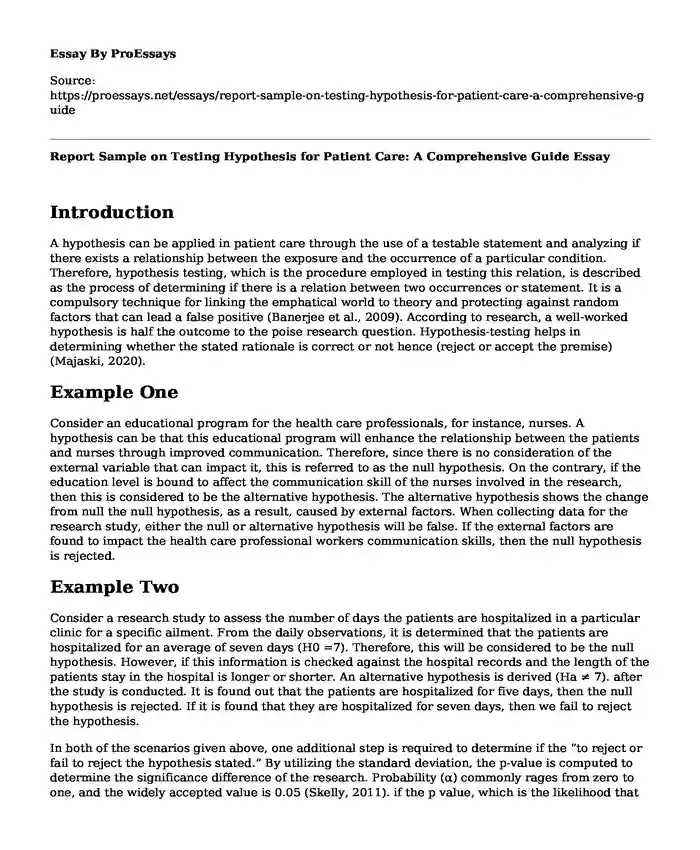Introduction
A hypothesis can be applied in patient care through the use of a testable statement and analyzing if there exists a relationship between the exposure and the occurrence of a particular condition. Therefore, hypothesis testing, which is the procedure employed in testing this relation, is described as the process of determining if there is a relation between two occurrences or statement. It is a compulsory technique for linking the emphatical world to theory and protecting against random factors that can lead a false positive (Banerjee et al., 2009). According to research, a well-worked hypothesis is half the outcome to the poise research question. Hypothesis-testing helps in determining whether the stated rationale is correct or not hence (reject or accept the premise) (Majaski, 2020).
Example One
Consider an educational program for the health care professionals, for instance, nurses. A hypothesis can be that this educational program will enhance the relationship between the patients and nurses through improved communication. Therefore, since there is no consideration of the external variable that can impact it, this is referred to as the null hypothesis. On the contrary, if the education level is bound to affect the communication skill of the nurses involved in the research, then this is considered to be the alternative hypothesis. The alternative hypothesis shows the change from null the null hypothesis, as a result, caused by external factors. When collecting data for the research study, either the null or alternative hypothesis will be false. If the external factors are found to impact the health care professional workers communication skills, then the null hypothesis is rejected.
Example Two
Consider a research study to assess the number of days the patients are hospitalized in a particular clinic for a specific ailment. From the daily observations, it is determined that the patients are hospitalized for an average of seven days (H0 =7). Therefore, this will be considered to be the null hypothesis. However, if this information is checked against the hospital records and the length of the patients stay in the hospital is longer or shorter. An alternative hypothesis is derived (Ha ≠ 7). after the study is conducted. It is found out that the patients are hospitalized for five days, then the null hypothesis is rejected. If it is found that they are hospitalized for seven days, then we fail to reject the hypothesis.
In both of the scenarios given above, one additional step is required to determine if the “to reject or fail to reject the hypothesis stated.” By utilizing the standard deviation, the p-value is computed to determine the significance difference of the research. Probability (α) commonly rages from zero to one, and the widely accepted value is 0.05 (Skelly, 2011). if the p value, which is the likelihood that assesses the evidence against the research null hypothesis is less than or equal to (α), in this case, the null supposition is rejected. However, if the p value is higher than the (α), then we fail to reject the null proposition.
Conclusion
Since the healthcare professional depends highly on evidence-based research, therefore the knowledge on statistic is essential for testing hypothesis. I experiment it is consequently vital to ensure that there is accuracy in the collection of the samples as well as the testing process to determine the best decision that can improve the patient’s care.
References
Banerjee, A., Jadhav, S., & Bhawalkar, J. (2009). Probability, clinical decision making and hypothesis testing. Industrial Psychiatry Journal, 18(1), 64. doi:10.4103/0972-6748.57864
Majaski, C. (2020, April 08). How Hypothesis Testing Works. Retrieved July 23, 2020, from https://www.investopedia.com/terms/h/hypothesistesting.asp
Skelly, A. (2011). Probability, proof, and clinical significance. Evidence-Based Spine-Care Journal, 2(04), 9-11. doi:10.1055/s-0031-1274751
Cite this page
Report Sample on Testing Hypothesis for Patient Care: A Comprehensive Guide. (2023, Oct 14). Retrieved from https://proessays.net/essays/report-sample-on-testing-hypothesis-for-patient-care-a-comprehensive-guide
If you are the original author of this essay and no longer wish to have it published on the ProEssays website, please click below to request its removal:
- Research Paper on Attention-Deficit Hyperactivity Disorder in School-Aged Kids
- Essay Sample on Cognitive Habits in Critical Thinking
- Social Problem: Neglected Conditions of Schools in Non-White and Poor Neighborhoods
- The Effect of Teaching Methods in Learning English Using the Qualitative Approach
- Essay Sample on Public Health and Environmental Interaction: Essential Waste Disposal Strategies
- Essay Example on Uniforms in Public Schools: The Growing Prevalence
- Free Essay Sample on Understanding Social Determinants & Cultural Awareness in Healthcare







